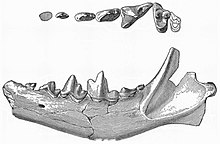

| Procynodictis
early to middle Eocene | |
|---|---|

| |
| lower jaw of Procynodictis vulpiceps | |
| Scientific classification | |
| Domain: | Eukaryota |
| Kingdom: | Animalia |
| Phylum: | Chordata |
| Class: | Mammalia |
| Clade: | Pan-Carnivora |
| Clade: | Carnivoramorpha |
| Clade: | Carnivoraformes |
| Genus: | †Procynodictis Wortman & Matthew, 1899 |
| Type species | |
| †Procynodictis vulpiceps Wortman & Matthew, 1899 | |
| Species | |
| Synonyms | |
|
synonyms of genus:
synonyms of species:
| |
Procynodictis ("before Cynodictis") is an extinct genus of placental mammals from clade Carnivoraformes, that lived in North America from the early to middle Eocene.[4][5][6]
| Procynodictis |
|
|---|---|
This prehistoric mammal-related article is a stub. You can help Wikipedia by expanding it. |